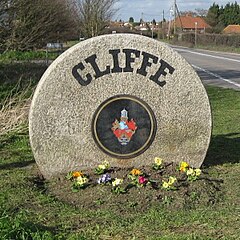Cliffe-at-Hoo
| Cliffe | |
|---|---|
 |
|
| Cliffe shown within Kent | |
| OS grid reference | TQ7347976679 |
| Civil parish | |
| District | |
| Shire county | |
| Region | |
| Country | England |
| Sovereign state | United Kingdom |
| Post town | ROCHESTER |
| Postcode district | ME3 |
| Dialling code | 01634 |
| Police | Kent |
| Fire | Kent |
| Ambulance | South East Coast |
| EU Parliament | South East England |
| UK Parliament | |
Cliffe is a village on the Hoo Peninsula in Kent, England, reached from the Medway Towns by a three-mile (4.8 km) journey along the B2000 road. Situated upon a low chalk escarpment overlooking the Thames marshes, Cliffe offers views of Southend-on-Sea and London. It forms part of the parish of Cliffe and Cliffe Woods in the borough of Medway. The population of the village is included in the civil parish of Cliffe and Cliffe Woods. In 774 Offa, King of Mercia, built a rustic wooden church dedicated to St Helen, a popular Mercian saint who was by legend the daughter of Coel ("Old King Cole") of Colchester. Cliffe is cited in early records as having been called Clive and Cliffe-at-Hoo.
Clovesho, or Clofeshoch, was an ancient Saxon town, in Mercia and near London, where the Anglo-Saxon Church is recorded as holding the important Councils of Clovesho between 742 and 825. These had representation from the archbishopric of Canterbury and the whole English church south of the Humber. The location of Cloveshoo has never been successfully identified, but in the 18th century Cliffe was thought to be one possible location.
The Grade I listed St Helen's church at Cliffe was built about 1260 and was constructed in the local style of alternating layers of Kent ragstone and squared black flint. It is one of the largest parish churches in Kent, and the only one dedicated to St Helen, the size of the church revealing its past importance. It contains wall paintings of the martyrdom of St. Edmund, a Jacobean pulpit, and fine stone carvings.
...
Wikipedia

